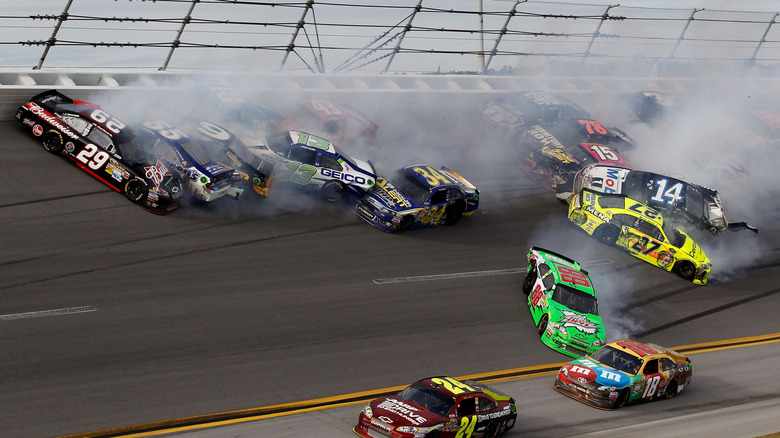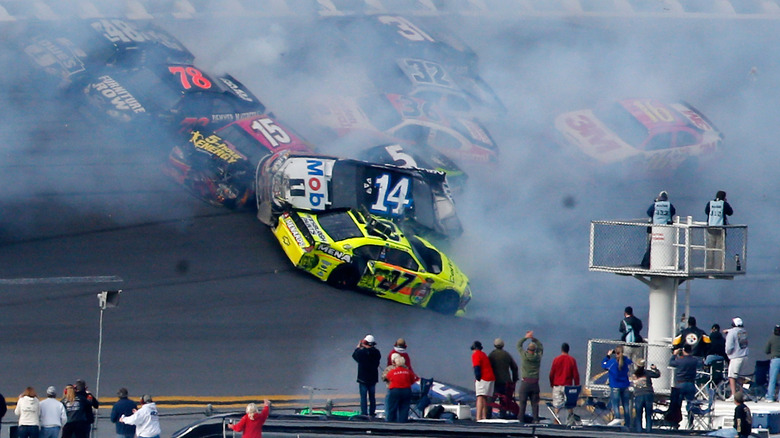5 Of The Worst NASCAR Crashes Of All Time
If there's one thing NASCAR is well-known for (aside from the racing, of course), it's the crashes. With cars frequently exceeding 200 mph and driving in close proximity to one another, crashes are basically an occupational hazard for drivers. That's not necessarily a bad thing as far as the spectacle goes, and as long as the drivers involved can walk away, crashes often become the highlights of certain races. Of course, that's not always the case, with many accidents resulting in tragic injuries or even deaths. When you're traveling at those sorts of speeds, the laws of physics take no prisoners, despite the many advanced safety features of modern stock cars, such as their aerodynamic roof flaps.
There are, of course, numerous standout moments that truly showcase the power and ferocity involved in these sorts of crashes. Some involve upwards of 20 or more vehicles, taking out over half the field in one shot. Others are simply one car losing control and hitting the wall so violently that the wreckage is barely recognizable. Sometimes the drivers escape unharmed, but there are ones that have led to some of NASCAR's most heartbreaking tragedies. One thing's for sure: You'll never know what you're going to get on race day.
Since the notion of "worst" is subjective, we've selected several different crashes that demonstrate different worst-case scenarios. From massive pileups to solitary heavy impacts, let's take a tour of the dark side of NASCAR. That said, note that we won't be discussing any accidents that resulted in fatalities or life-threatening injuries.
The big one: Talladega 2002
This is the single largest crash in modern NASCAR history in terms of the number of cars involved: 31 cars in total. The 2002 Aaron's 312 at Talladega was a 312-mile long race covering 117 laps of the 2.66-mile Talladega Superspeedway, with 43 cars on the grid. Johnny Sauter qualified on pole here and remained out in front for 11 laps before falling back in and jostling for position. The cars had just entered the back straight and were looking to sit in the slipstream to gain some speed — in NASCAR's case, allowing them to go almost as fast as F1 cars.
Slipstreaming (or lack thereof) is what triggered the crash. Driver Kenny Wallace didn't have enough speed coming out of the banking because his car was out of the slipstream, meaning the car "washed out" and was slow onto the straight. This caused the car behind, driven by Scott Riggs, to have to take avoiding action during a pass. Riggs let off the throttle, leading Shane Hmiel to hit the back of his car, which then resulted in Kevin Grubb crashing into Hmiel's rear. This three-car chain then turned left on the straightaway, striking Sauter's car in the side and launching it onto its roof.
Because the accident happened before the pack spread out (as it does later in the race), it quickly cascaded due to all the bunched-up cars. Over three-quarters of the field was involved, and the race was red-flagged for 40 minutes. There were an astonishing nine DNFs from the lap 14 crash alone.
The can opener: Bristol 1990
If you've ever wondered what hitting a guardrail head-on at NASCAR speeds would do to one of these machines, this is it. Michael Waltrip was driving on the infamous Bristol Motor Speedway, a short, slow-speed track that's just over a half-mile per lap. Overtakes here are known to take multiple laps to complete, and it's known as one of the most demanding tracks on today's calendar. This was certainly just as true back in 1990, though one would assume that the track's slower speeds would reduce the severity of any crashes. But it's not necessarily about pure numbers — rather, it's how the car impacts the surface.
No crash demonstrates the absolute importance of safety barriers more than Michael Waltrip's 1990 accident. Coming out of the second corner on the outside, his car breaks traction and slides into the outside wall. Normally, this wouldn't be a huge issue, except the car broke through a gate that was improperly locked and effectively skewered itself on the guardrail, violently ripping the car open and leaving the wreck almost unrecognizable. The force was so great that the steering wheel was jutting out at nearly 90 degrees, facing the car's left.
Miraculously, Waltrip not only survived the ordeal but actually raced in the Valleydale Meats 500 the next day, qualifying and finishing in 20th place. This goes to show that no matter how well-prepared stock cars are with rollcages and advanced aerodynamics, all it takes is one crucial error to place someone in a life-threatening situation. Similar levels of destruction occurred in other forms of motorsports, such as in some of IndyCar's worst crashes.
Not always on an oval: Watkins Glen 2009
Better known as "The Glen," Watkins Glen International Raceway in upstate New York is one of the few races on NASCAR's regular calendar that isn't an oval. Stock cars visit several road courses, such as Race Sonoma, though you don't typically see huge crashes there. Much like the GT racing that occurs on these circuits, accidents tend to be relatively mild in comparison to the 200-plus mph incidents resulting in twisted metal strewn all over a straightaway. However, for every rule, there is an exception, and that occurred here coming out of Turn 5.
Watkins Glen is one of several circuits with multiple configurations, and this particular race used its shorter seven-turn layout. The track deviates at Turn 5, known as the Outer Loop, with the barrier lined with tire bundles to keep cars from impacting the wall at speed if they hit the grass. Unfortunately, these tire bundles sometimes spit the cars back out onto the track, which is what happened in this incident. The crash started as a minor incident when Kasey Kane lost traction on the exit of Turn 5 and struck Sam Hornish, Jr. on the outside, forcing him into the tire bundle. His car violently spun around and was launched back onto the track, where it was struck by Jeff Gordon and Jeff Burton. Gordon had no time to avoid and was forced into the barrier.
Thankfully, all drivers walked away from this accident, which would surely have been far more devastating if the barriers hadn't been up to par. While relatively minor in terms of overall damage, this accident illustrates the visceral results of even slight errors during close racing on road courses.
Last lap carnage: Talladega 2012
Imagine it: the race has two laps to go and you've just come out of a full-course caution. You're right behind the lead group and are bump drafting to a hopeful victory, with cars behind you going four wide across the track. Everyone is jostling for position, and all it takes is a single misstep to end the race for almost the entire field. That's exactly what occurred during one fateful race in 2012 at Talladega, where the cars were rounding the final corner with the checkered flag less than a mile away.
This accident likely occurred because of two factors: everyone being in proximity to one another, and drivers desperately bump drafting for the best positions. Bump drafting means that you're actively pushing the car in front of you, using your momentum from the lack of air resistance to help the car you're following go faster. It's a legitimate tactic done all the time in NASCAR. Bump drafting is what caused this incident, though when Casey Mears bumped Michael Waltrip past race leader Tony Stewart. Mears and Waltrip were carrying far greater speed than Stewart, who likely wasn't expecting the pair to be in the lower lane so quickly. Moving down to defend, his rear-left quarter panel contacted Waltrip, leading to him spinning out and going backwards into the rest of the field. Almost no car was left unscathed by the time the checkered flag fell.
The race results were determined based on race positions when the caution was called, with Matt Kenseth securing victory by virtue of not being involved in the accident. The most major injury was Dale Earnhardt, Jr. suffering a concussion, a sadly common occurrence in the sport.
Catching a car: Daytona 2012
Unlike most other crashes, this one actually occurred after the cars had crossed the finish line, and it illustrates all of the points we've mentioned for the other crashes. We probably don't think much of the chain-link fences lining the tracks, which help prevent debris from flying into the crowd. Once in a blue moon, though, that debris happens to be a car traveling at around 200 mph, as was the case in the 2015 Coke Zero Daytona 400.
This crash occurred on the inside lane, once again with a large number of cars close to each other after a full-course caution. As the race was restarting with two laps remaining, Kevin Harvick, driving the Number 4 car, crashed into Denny Hamlin from behind, pushing him sideways across the line. Chaos quickly ensued, resulting in Austin Dillon's car hitting Hamlin's at around 200 mph, throwing the car in the air. Dillon's car soared over the entire field and smashed directly into the catch fence at full racing speed. The resulting impact shredded the car and sent debris flying into the stands, injuring fans and resulting in a lawsuit.
All the stars had to align for this one. The accident damaged over 20 cars in one swoop, and it involved one of the most violent deceleration events in NASCAR that still saw all the drivers walk away. Moreover, it demonstrates just how robust the trackside safety devices really are if even the humble catch fence can successfully withstand a direct hit from a full-speed Cup car (and NASCAR Cup cars go extremely fast on superspeedways). It's truly miraculous that it wasn't more disastrous than it was, and we hopefully won't see the fencing tested similarly anytime soon.

